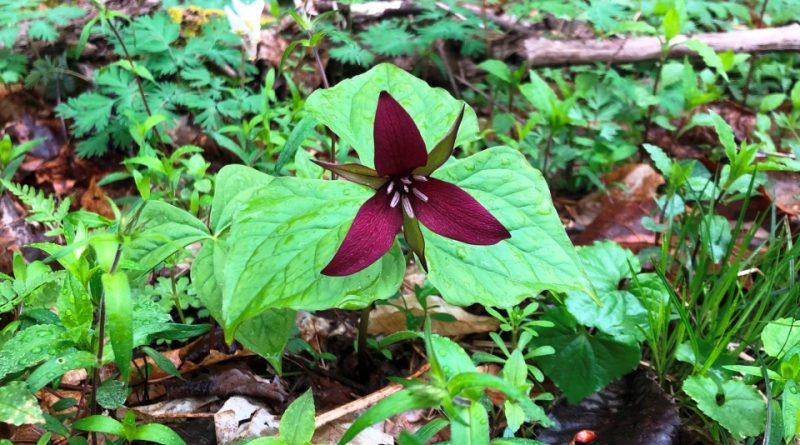Trillium erectum
Trillium erectum
The red trillium (Trillium erectum L.) is a herbaceous species belonging to the Melanthiaceae family.
Systematics –
Eukaryota Domain,
Kingdom Plantae,
Magnoliophyta Division,
Liliopsida class,
Subclass Liliidae,
Order Liliales,
Family Melanthiaceae*,
Genus Trillium,
T. erectum species.
Within this species, the following varieties are recognized:
– Trillium erectum var. album (Michx.) Pursh;
– Trillium erectum var. erectum.
Etymology –
The term Trillium comes from the Greek τρέις tréis tre: triple because it has three leaves and three styles and the chalice is divided into three.
The specific epithet erectum due to the erect, upright posture.
Geographic Distribution and Habitat –
Trillium erectum is a plant native to the eastern United States and eastern Canada, whose range goes from northern Georgia to Quebec and New Brunswick.
This plant is present in the following provinces and states:
– in Canada: New Brunswick, Nova Scotia, Ontario, Quebec;
– in the United States: Connecticut, Delaware, Georgia, Illinois, Indiana, Kentucky, Maine, Maryland, Massachusetts, Michigan, New Hampshire, New Jersey, New York, North Carolina, Ohio, Pennsylvania, Rhode Island, South Carolina, Tennessee, Vermont , Virginia, West Virginia.
Its habitat is that of fresh, rich, humid, neutral to acid soils of mountain broad-leaved forests, mixed broad-leaved and coniferous forests, edges of coniferous swamps at altitudes of 200 – 700 meters above sea level, with an ephemeral cycle synchronized with that of the forests in which it lives.
Description –
Trillium erectum is a perennial herb that grows up to about 40 cm in height with a width of about 30 cm.
The leaves, like all parts, are in groups of three; they are large, with a lanceolate shape, ending with an evident tip and with evident ribs
The flowers have 3 petals, positioned above a stage of leaves. The petals are dark maroon, maroon, purple, pale yellow or white. The ovary ranges from dark purple to brown, regardless of the color of the petals.
If the flower is successfully pollinated, the petals wither, leaving a fruit that ripens into a dark red berry-like capsule 1 to 1.5 centimeters long.
Cultivation –
Trillium erectum is a plant that tolerates extreme cold in winter, surviving temperatures as low as -35 ° C.
To be cultivated, it prefers well-drained, humus-rich soil in a slightly shaded position that maintains good summer humidity.
The soil pH should be neutral to slightly acidic.
Propagation occurs by seed with sowing as soon as it ripens in seedbeds or open shaded fields.
Stored seeds should be sown in late winter or early spring. The seed usually germinates within 1 – 3 months at 15 ° C.
The young seedlings must be watered carefully, but avoiding stagnation of water.
It can also be propagated by division and the larger ones can be planted directly in the open field in spring.
Customs and Traditions –
Trillium erectum was first described by the Swedish botanist Carl Linnaeus in 1753 and is a plant whose leaves give off an unpleasant odor.
In 1803 André Michaux introduced the name Trillium rhomboideum to describe a form of T. erectum with black fruits in the “high mountains of North Carolina”. The specific rhomboideum epithet refers to the broadly rhombic leaves of this (and all) forms of T. erectum. Michaux also described Trillium rhomboideum var. atropurpureum, a variety with large dark purple petals. A decade later, in 1813, Frederick Traugott Pursh referred to the Michaux variety more simply as Trillium erectum var. atropurpureum. Perhaps unaware of these taxonomic developments, other botanists have subsequently described Trillium atropurpureum. The epithet atropurpureum means “dark purple”, a reference to the color of the petals of some forms of T. erectum. In fact, in some locations T. erectum is commonly known as the purple trillium.
The root of Trillium erectum was used in the past by various indigenous peoples of North America as an aid in childbirth, hence the local common name of birthwort or birthroot. Root tea was used for menstrual disorders, to induce childbirth, and to aid in labor. The Cherokee peoples used a whole plant poultice to treat tumors, inflammation and ulcers.
The leaves contain calcium oxalate crystals and should not be consumed by humans.
Preparation Method –
Of the Trillium erectum, especially once, the roots of the indigenous peoples of North America were used with used in various ways or in the form of a tea.
The Cherokee peoples used a poultice of the whole plant for various medicinal remedies but, at present, the medical uses of this plant have almost completely disappeared.
* This grouping is not, in fact, contemplated by the Cronquist System (1981) which includes its species among the Liliaceae.
Guido Bissanti
Sources
– Acta Plantarum – Flora of the Italian Regions.
– Wikipedia, the free encyclopedia.
– GBIF, the Global Biodiversity Information Facility.
– Useful Tropical Plants Database.
– Conti F., Abbate G., Alessandrini A., Blasi C. (ed.), 2005. An annotated checklist of the Italian vascular flora, Palombi Editore.
– Pignatti S., 1982. Flora of Italy, Edagricole, Bologna.
– Treben M., 2000. Health from the Lord’s Pharmacy, Advice and experiences with medicinal herbs, Ennsthaler Editore.
Photo source:
– https://inaturalist-open-data.s3.amazonaws.com/photos/186475954/original.jpg
Warning: Pharmaceutical applications and alimurgical uses are indicated for informational purposes only, they do not represent in any way a medical prescription; therefore no responsibility is taken for their use for curative, aesthetic or food purposes.


